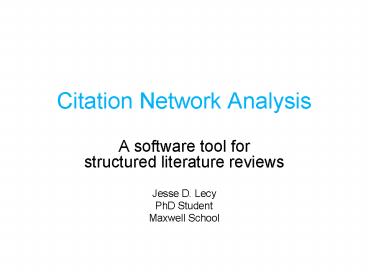Citation Network Analysis - PowerPoint PPT Presentation
1 / 58
Title:
Citation Network Analysis
Description:
... through a steady accumulation of knowledge, but rather 'a series of peaceful ... that presents the results of a bibliometric analysis of the knowledge domains ... – PowerPoint PPT presentation
Number of Views:637
Avg rating:3.0/5.0
Title: Citation Network Analysis
1
Citation Network Analysis
- A software tool for structured literature
reviews - Jesse D. Lecy
- PhD Student
- Maxwell School
2
Motivation The Structure of Scientific
Revolutions
Science does not occur through a steady
accumulation of knowledge, but rather "a series
of peaceful interludes punctuated by
intellectually violent revolutions, during which
"one conceptual world view is replaced by
another."
This book is a study of paradigm shifts in
science
Thomas Kuhn
3
The Structure of Scientific Revolutions
"Though each may hope to convert the other to his
way of seeing science and its problems, neither
may hope to prove his case. The competition
between paradigms is not the sort of battle that
can be resolved by proof." (SSR, p. 148)
"a new scientific truth does not triumph by
convincing its opponents and making them see the
light, but rather because its opponents
eventually die, and a new generation grows up
that is familiar with it." (SSR, p. 152)
4
The Sociology of Peer Review
- A unique language and culture develops in field.
It is difficult for researchers to collaborate
outside of their fields, and there are often few
incentives to do so. - It is rewarding to work within a research
paradigm you can find camaraderie and work with
people who value the problems that you value. - The peer review process can be politicized
preferential treatment of authors, institutions,
methods, or research findings. - As a result, researchers will organize themselves
by field. - Can these dynamics be ignored when doing a
literature review?
5
The Classic Literature Review
- A literature review discusses published
information in a particular subject area,
sometimes within a certain time period. - Usually accomplished through
- Keyword searches
- In academic journal databases
- And selective reading of papers
http//www.unc.edu/depts/wcweb/handouts/literature
_review.html
6
The Alternative Citation Networks
Advocacy Networks
CorporateResponsibility
InternationalInstitutionReform
Security
NGOAccountability
Philanthropy
Global Environmentalism
Global Civil Society
Diasporas AsSocial Movements
Faith Based NGOs
Elections
7
Structure Everywhere Not All Publications are
Equal
Quoted from the Web of Science In the
mid-1930's S. C. Bradford realized thatan
essential core of journals forms the literature
basis for all disciplines, and that most of the
important papers are published in relatively few
journals (Bradfords law). An analysis of 7,528
journals covered in the 2005 Journal Citation
Reports revealed that as few as 300 journals
account for more than 50 of what is cited and
more than 25 of what is published. A core of
3,000 of these journals accounts for about 75 of
published articles and over 90 of cited
articles. Furthermore, this core is not static.
Its basic composition changes constantly
reflecting the evolution of scholarly topics.
How Can we identify this structure during a
literature review?
http//scientific.thomson.com/free/essays/selectio
nofmaterial/journalselection/
8
(No Transcript)
9
Recent Publication Using CNs
http//www.public.asu.edu/majansse/pubs/Supplemen
tIHDP.htm
This is a background supplement of a paper that
presents the results of a bibliometric analysis
of the knowledge domains resilience,
vulnerability and adaptation within the research
activities on human dimensions of global
environmental change. We analyzed how 2,286
publications over the last 30 years are related
in terms of co-authorship relations and citation
relations. - Scholarly Networks on
Resilience, Vulnerability and Adaptation, Global
Environmental Change, 2006.
10
The Dawn of Bibliometric Analysis
Eugene Garfield
Larry Page and Sergey Brin
11
Software for Generating Citation Networks
Citation Network Analyzer
Photo credit Konstantinos Kokkinis
12
What HistCite Does
Size of the node represents the number of times
the article is cited The number is the reference
to the paper
13
Problems with HistCite
- HistCite is linked to the Web of Science, which
is a subscription only database with limitations
on their journal subscriptions - HistCite costs 200
Google Scholar, The New Generation of Citation
Indexes, Noruzi, 2005
14
Alternatively
Citation Network Analyzer
15
How CNA WorksStep 1 Finding Seed Articles
Seminal papers to a field identified by keyword
searches or consultation with domain experts
Seeds
16
Distilling the Network
17
Identifying Subfields of a Lit Review on NGOS
Advocacy Networks
CorporateResponsibility
InternationalInstitutionReform
Security
NGOAccountability
Philanthropy
Global Environmentalism
Global Civil Society
Diasporas AsSocial Movements
Faith Based NGOs
Elections
18
Invisible Colleges Author Networks
19
Invisible Colleges Cliques
20
Invisible Colleges Ego-nets
21
Other Analysis
Most Common Journals in the Network
22
Demonstration of the Software
23
Sampling Framework
- Broad and Shallow
24
(No Transcript)
25
(No Transcript)
26
(No Transcript)
27
(No Transcript)
28
Sampling Framework
- Concept of Levels
29
(No Transcript)
30
Sampling Framework
- Narrow and Deep
31
All articles on first level
32
High percentage samples on second level (50)
33
Slightly less on third level (20)
34
Small amount samples on subsequent levels (5-10)
35
Sampling Framework
- Multiple Titles
36
(No Transcript)
37
(No Transcript)
38
(No Transcript)
39
Generating a Network
40
(No Transcript)
41
(No Transcript)
42
(No Transcript)
43
(No Transcript)
44
Example Analysis
45
Challenges Large Networks
Hierarchical Clustering
46
Representing Structure Efficiently Using
Clustering
47
Clustering Complex Networks
48
Example Analysis of Sub-Fields
49
Dendrogram from Clustering in R
50
Subfield on Transnational Migration
TransnationalMigration
51
Subfield on Gender
Gender
52
Subfield on Social Movements
Social Movements
53
Example Analysis of Converging Literatures NGOs
- NGO Research Occurs in
- Diverse Fields
- Econ Development
- Constructivism
- International Non-Profits
54
Seed 1 Constructivism
55
Seeds 1 2 Constructivism plus Intermediary
NGOs
56
Seeds 1 3Constructivism plus International
Nonprofits
57
Seeds 1, 2 3
58
To obtain the program
http//www.justroots.info/CitationNetworkAnalyzer/
CNA.zip Or contact Jesse Lecyat
jdlecy_at_syr.edu































